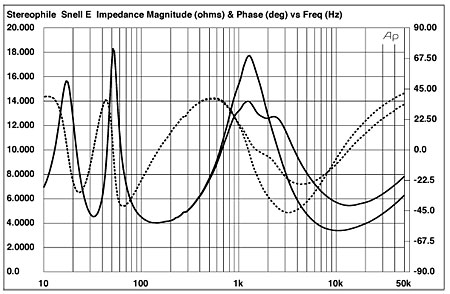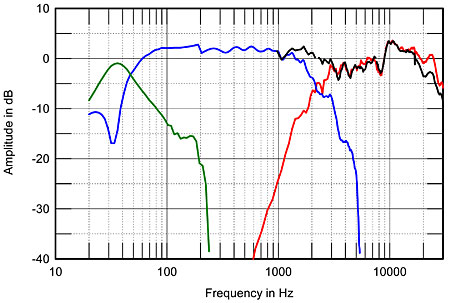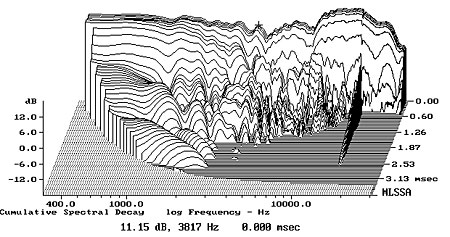| Columns Retired Columns & Blogs |
Snell Type E/III loudspeaker Measurements
Sidebar 3: Measurements
Before Tom Norton sent the E/IIIs off to Larry for auditioning, I ran them through a subset of my basically standardized set of tests. Fig.1 shows the speaker's impedance and electrical phase. (The twin curves in the treble show the tweeter-level control set to its minimum and maximum positions.) Dropping to 4 ohms or below only in the upper bass (and the high treble when the level control is set to its maximum position), the E/III is reasonably easy for an amplifier to drive. Even relatively inexpensive electronics—vide LG's antique Lafayette receiver—should have no problems driving the speakers to reasonable levels.

Fig.1 Snell E/III, electrical impedance (solid) and phase (dashed), shwoing the effect of the tweeter control (min/max). (2 ohms/vertical div.)
The woofer tuning is revealed by the trough centered on 33Hz, this figure suggesting good bass extension, as noted by LG in his auditioning.
In the frequency domain, the black trace in fig.2 shows the speaker's anechoic response averaged across a 30° horizontal angle on the tweeter axis at a distance of 44" with the tweeter control at 9 o'clock and the grille on. (The B&K microphone's own departure from flat response has been subtracted mathematically.) Very smooth through the important midrange, there is a slight lack of energy just above the crossover region, above which the top octave of the treble stands a little proud on this axis. The tweeter's response is shown in red, the woofer's in blue; the acoustic crossover point is just above 2kHz, very slightly lower than specified.

Fig.2 Snell E/III, anechoic response on tweeter axis at 44" (black), corrected for microphone response, with individual responses of the tweeter (red), woofer (blue), and port (green), measured in the nearfield below 300Hz.
To the left of fig.2 are shown the individual responses of the woofer (blue) and the port (red) measured in the nearfield (ie, with the microphone capsule almost touching the dustcap in the former case, and positioned about ¼" in front of the port center in the other). The level matching of these curves with the anechoic response to their right can only be approximate, but they confirm that this Snell does have excellent bass performance, the relatively large enclosure allowing the woofer to effectively reproduce instruments down to 50Hz, a few notes above the bottom of the double-bass's fundamental region, the port supplementing that output down to 30Hz or so. This is about the most extended bass I have seen in a modestly priced loudspeaker that also offers a musically neutral midrange.
That the speaker has excellent dispersion is confirmed by fig.3, which shows just the differences in response as the listener moves first 7.5°, then 15° off the frontal axis. These curves suggest that the E/III offers the flattest treble response when listened to a little off-axis; ie, either not toed-in all the way to the listener position, or toed-in to cross the speakers' axes just in front of the listener. Either way, you get a basically neutral tonal balance at an affordable price.

Fig.3 Snell E/III, lateral response family at 44", normalized to response on tweeter axis, from back to front: differences in response 15–7.5° off axis, reference response, differences in response 7.5–15° off axis.
Turning to the time domain, fig.4 shows the speaker's impulse response on the tweeter axis, which implies a highish-order crossover. This was confirmed by fig.5, the step response,a s well as looking at the individual responses of the two drive-units, which indicate 24dB/octave acoustic slopes. However, fig.5 also suggests that the optimal listening axis is just below the tweeter, which is perhaps one reason why Snell recommends using this nominal floorstanding speaker on short stands.

Fig.4 Snell E/III, impulse response on tweeter axis at 44" (5ms time window, 30kHz bandwidth).

Fig.5 Snell E/III, step response on tweeter axis at 44" (5ms time window, 30kHz bandwidth).
Mathematically processing this impulse to show how the frequency response changes as the sound decays gives the "waterfall" plot in fig.6 (ignore the black ridge at 15,750Hz, which is due to the computer's monitor frequency). Some hash can be seen in the treble, as can some complicated midrange behavior, but both are at least 12dB down from the initial sound level. The complex ridge at 3kHz and the small residual at 5kHz are probably due to woofer breakup modes, but both are well down in level. Overall, the Snell E/III is relatively free from coloration-inducing resonant behavior.

Fig.6 Snell E/III, cumulative spectral-decay plot at 44" (0.15ms risetime).
To sum up these measurements, they indicate a tonally neutral, low-coloration design with excellent bass performance at its price. I am not surprised LG was so enthusiastic in his recommendation.—John Atkinson
- Log in or register to post comments




































